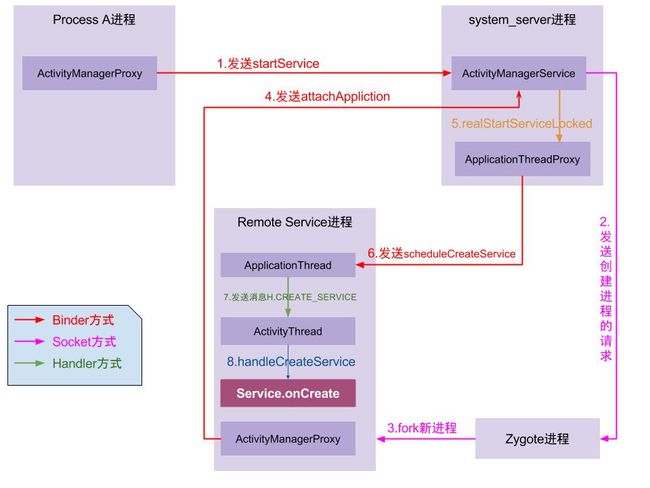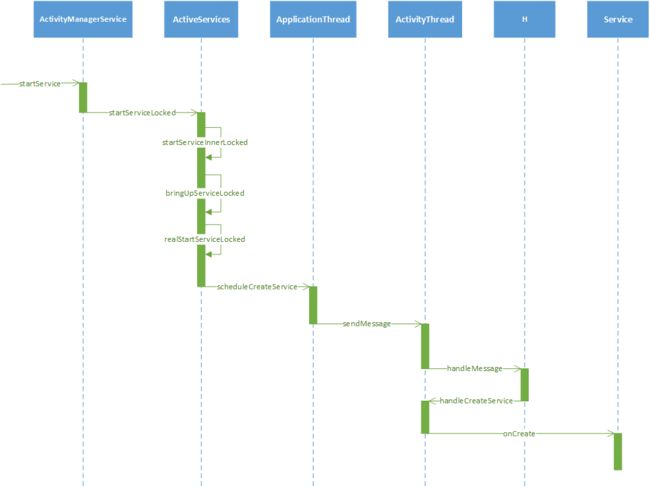Service启动过程与Activity类似,了解了Activity启动之后来看Service就容易了,那么还是来简单过一下流程,先看一张整体流程图:
应用层startService 最终通过Binder IPC 到AMS:
Context关系以后再讲,这里其实我们都知道Context是个抽象类,真正干活的是ContextImpl. 由它执行真正的startService操作:
@Override
public ComponentName startService(Intent service) {
warnIfCallingFromSystemProcess();
return startServiceCommon(service, false, mUser);
}
private ComponentName startServiceCommon(Intent service, boolean requireForeground,
UserHandle user) {
try {
...
ComponentName cn = ActivityManager.getService().startService(
mMainThread.getApplicationThread(), service, service.resolveTypeIfNeeded(
getContentResolver()), requireForeground,
getOpPackageName(), user.getIdentifier());
...
}
这是典型的binder ipc过程了,话不多说。
frameworks/base/services/core/java/com/android/server/am/ActivityManagerService.java
@Override
public ComponentName startService(IApplicationThread caller, Intent service,
String resolvedType, boolean requireForeground, String callingPackage, int userId)
throws TransactionTooLargeException {
...
res = mServices.startServiceLocked(caller, service,
resolvedType, callingPid, callingUid,
requireForeground, callingPackage, userId);
...
return res;
}
}
执行startServiceLocked:
frameworks/base/services/core/java/com/android/server/am/ActiveServices.java
ComponentName startServiceLocked(IApplicationThread caller, Intent service, String resolvedType,
int callingPid, int callingUid, String callingPackage, final int userId)
throws TransactionTooLargeException {
...
return startServiceInnerLocked(smap, service, r, callerFg, addToStarting);
}
ComponentName startServiceInnerLocked(ServiceMap smap, Intent service, ServiceRecord r,
boolean callerFg, boolean addToStarting) throws TransactionTooLargeException {
...
String error = bringUpServiceLocked(r, service.getFlags(), callerFg, false, false);
...
return r.name;
}
startServiceLocked 和startServiceInnerLocked 对应于Activity中的startActivityMayWait和startActivity的过程,无非也就是一些检验和初始化的工作。而startServiceInnerLocked方法中又调用了bringUpServiceLocked方法.
private String bringUpServiceLocked(ServiceRecord r, int intentFlags, boolean execInFg,
boolean whileRestarting, boolean permissionsReviewRequired)
throws TransactionTooLargeException {
...
final String procName = r.processName;
ProcessRecord app;
if (!isolated) {
app = mAm.getProcessRecordLocked(procName, r.appInfo.uid, false);
if (DEBUG_MU) Slog.v(TAG_MU, "bringUpServiceLocked: appInfo.uid=" + r.appInfo.uid
+ " app=" + app);
if (app != null && app.thread != null) {
try {
app.addPackage(r.appInfo.packageName, r.appInfo.versionCode,
mAm.mProcessStats);
realStartServiceLocked(r, app, execInFg);
return null;
}
...
if (app == null && !permissionsReviewRequired) {
if ((app=mAm.startProcessLocked(procName, r.appInfo, true, intentFlags,
"service", r.name, false, isolated, false)) == null) {
...
}
...
}
...
}
该方法可以对比于Activity启动的startSpecificActivityLocked,也是一个分叉路,如果进程存在则调用realStartServiceLocked去schedule Service应用层的启动,如果不存在,则socket通知Zygote去fork进程,然后再回来schedule Service。Zygote去fork进程部分与Activity启动部分并无太大差别,那么直接来看startSpecificActivityLocked:
private final void realStartServiceLocked(ServiceRecord r,
ProcessRecord app, boolean execInFg) throws RemoteException {
...
try {
...
app.thread.scheduleCreateService(r, r.serviceInfo,
mAm.compatibilityInfoForPackageLocked(r.serviceInfo.applicationInfo),
app.repProcState);
r.postNotification();
created = true;
} catch (DeadObjectException e) {
...
}
...
}
app.thread是IApplicationThread类型的,它的实现是ActivityThread的内部类ApplicationThread。
frameworks/base/core/java/android/app/ActivityThread.java
public final void scheduleCreateService(IBinder token,
ServiceInfo info, CompatibilityInfo compatInfo, int processState) {
updateProcessState(processState, false);
CreateServiceData s = new CreateServiceData();
s.token = token;
s.info = info;
s.compatInfo = compatInfo;
sendMessage(H.CREATE_SERVICE, s);
}
到了ActivityThread的地界,那就是靠消息驱动运转的世界了,由H发送CREATE_SERVICE的消息,然后在handleMessage对应的case中执行的是handleCreateService
private void handleCreateService(CreateServiceData data) {
unscheduleGcIdler();
LoadedApk packageInfo = getPackageInfoNoCheck(
data.info.applicationInfo, data.compatInfo);
Service service = null;
try {
java.lang.ClassLoader cl = packageInfo.getClassLoader();
service = (Service) cl.loadClass(data.info.name).newInstance();
} catch (Exception e) {
...
}
}
try {
if (localLOGV) Slog.v(TAG, "Creating service " + data.info.name);
ContextImpl context = ContextImpl.createAppContext(this, packageInfo);//4
context.setOuterContext(service);
Application app = packageInfo.makeApplication(false, mInstrumentation);
service.attach(context, this, data.info.name, data.token, app,
ActivityManagerNative.getDefault());//5
service.onCreate();//6
mServices.put(data.token, service);//7
...
} catch (Exception e) {
...
}
}
这里主要干两件事:
将service load到内存
通过Service的attach方法来初始化Service,然后走Service的onCreate方法,这样Service就启动了。
好了今天就简单地总结了下Service的启动过程,下篇接着看看Service的绑定过程。
参考:
http://gityuan.com/2016/03/06/start-service/
http://liuwangshu.cn/framework/component/2-service-start.html



